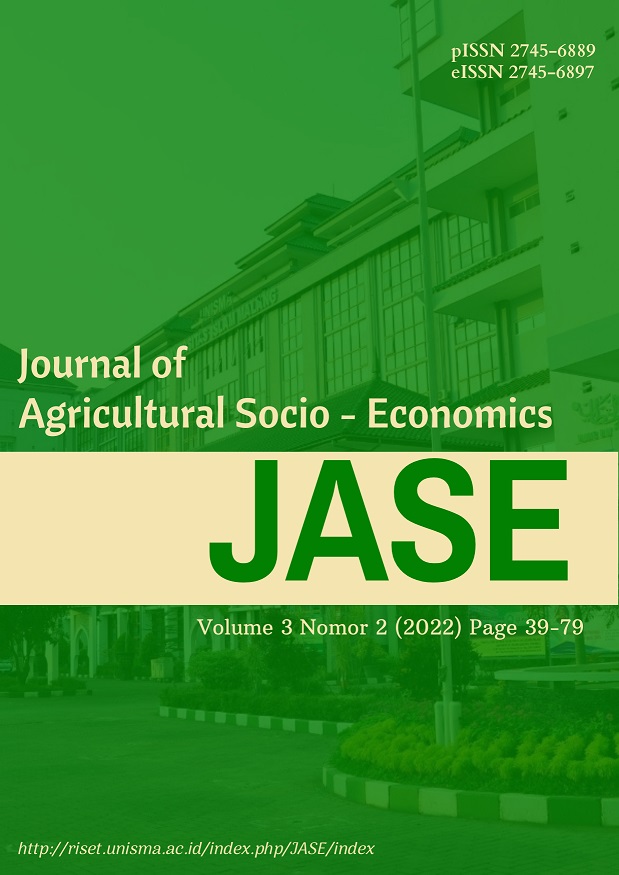SOCIO-ECONOMIC AND PROFITABILITY ANALYSIS OF RETAILING FROZEN FISH IN RIVERS STATE NIGERIA
DOI:
https://doi.org/10.33474/jase.v3i2.17606Keywords:
Profitability index, Net income, Rate of return, Operating ratio.Abstract
This study was designed to investigate the socio-economic and profitability of the frozen fish retailing business in Rivers State, Nigeria from March to August 2021. During the study period, a total of 80 frozen fish retailers were selected randomly for this study. Descriptive statistics, budgetary analysis, and multiple regression analysis were used for the analysis. The result of the findings revealed that most (62.5%) of the respondents were within the age range of 31–50 years. A majority (79.5%) of the respondents had acceptable levels of formal education. Results also revealed that fish marketing in the area is dominated by females, with most (70%) of the respondents being married. Most of the respondents had enough experience in fish marketing. The estimate of cost and return analysis shows a net income (NI) of N106, 837.56 per annum. The profitability index was 0.56, indicating that out of every Naira earned, about 56 kobo was returned to the frozen fish retailers as net income. The rate of return on variable cost was estimated to be 29.55%, which means that every Naira spent on variable inputs generates about N30 on a monthly basis, implying improved enterprise profitability. The operating ratio was 0.29, indicating greater total revenue over total variable costs, which is very good for the business, while education and fish quantity sold were positive and significant at 5 percentReferences
Adebayo, O. O. & Daramola, O. A. (2013). Economic analysis of catfish (Clarias gariepinus) production in Ibadan metropolis. Discourse Journal of Agriculture and Food Sciences, 1 (7):128-134
Agom, D. I., Etim, G. C. & Etuk, E. A. (2012). Analysis of Wholesale Frozen Fish Markets in Calabar, Cross River State, Nigeria. Trends in Agricultural Economics, 5:61-69. DOI: 10.3923/tae.2012.61.69
Ahituv, A. & Lerman, R. I. (2005). How Do Marital Status, Wage Rates, and Work Commitment Interact? Demography, 44(3):623-647.
Agbo, D. A. (2015). Bridging the fish demand and supply gap in Nigeria. Retrieved September 15, 2016 from, http://www.dailytrust.com.ng/daily/index.php/agriculture/54661-bridging-the-fishdemand-supply-gap-in-nigeria.
Ali, M. M., Rahman, M. M., Hossain, M. Y., Rahman, M. Z., Hossen, M. A., Naser, S. M. A., Islam, R., Subba, B. R., Masood, Z. & Hoque, M.A. (2014). Fish marketing system in southern Bangladesh: Recommendations for efficient marketing. Our Nature, 12.1:28-36.
Atanda, A. N. (2012) Fish species diversification in Agriculture for the success of the agriculture transformation agenda: Ðe role of tilapia production; Fisheries Society of Nigeria (FISON) annual public lecture, Lagos, Nigeria
Babalola, M. O. (1976).Fresh fish marketing around Kaniji Dam. The Nigerian Trade Journal, 23:2-5.
CBI 1996. Fishery Products. A survey of the Netherlands and other major markets in the Eurpean Union. Published: Rotterdam: CBI, 1996 154pp.
Esiobu, N. S & Onubuogu, O. C. (2014). Socio-economic Analysis of Frozen Fish Marketing in Owerri Municipal Council Area, Imo State, Nigeria: An Econometric Model Approach. Journal of Agricultural Science, 4(8):449-459
FAO (2016). Food Agriculture Organization, 2014. Livestock Primary. Food and Agriculture Organization of the United Nations.
FAO (2018). Food and Agriculture Organization. 2018. The state of world fisheries and aquaculture: Meeting the Sustainable Development Goals. Rome: FAO. ftp://ftp.fao.org/docrep/fao/011/i0250e/i0250e.pdf
Igoni-Egweke Q.N. (2018). Analysis of value addition in commercial Catfish (Clarias Gariepinus Heterobranchus spp.) production in Rivers State, Nigeria. Federal University of Technology, Owerri.
Jiang, S. (2010). Aquaculture, capture fisheries, and wild fish stocks. Resource and Energy Economics, 32: 65 –77.
Muhammed, U. (2011). Market Chain Analysis of Teff and Wheat Production in Halaba Special Woreda, Southern Ethiopia. M.Sc. Thesis Submitted to the School of Graduate Studies. Haramaya University. 8-11.
Kikiope, O. (2018). NIGERIA: Importing fish amidst abundant ocean resources, the paradox of a nation international Centre for Investigative Reporting. Earth journalism network
Ojo, S. O. (2003). Productivity and technical efficiency of poultry egg production in Nigeria. International Journal of Poultry Science 2:459-464.
Okeoghene, E.S. (2013). Assessment of the marketing of Frozen Fish (Iced Fish) in Edo State, Nigeria. Asian Journal of Business Management, 5.4: 353-357.
Onubuogu, G. C., Esiobu, N. S., Nwosu, C. S. & Okereke, C. N. (2014). Resource use efficiency of smallholder cassava farmers in Owerri Agricultural zone, Imo State, Nigeria. Scholarly Journal of Agriculture. Science, 7(8):142-152
Pala, A. O. (1976). African Women in Rural Development Research, Trends and Priorities. Overseas Liason Committee, Afr. Council on Edu. Paper 12, pp. 5-8.
Trondsen, T. (1997). Marketing potential and barriers for fresh packed fish. Journal of Food Products Marketing, 4: 79–99.
Umoinyang, M. A. (2014). Economics of Fish Marketing in Akwa Ibom State, Nigeria. MSc Dissetation, Department of Agricultural Economics, University of Nigeria, Nsukka. X+ 72
Downloads
Published
How to Cite
Issue
Section
License
Copyright (c) 2022 olaniyi olopade

This work is licensed under a Creative Commons Attribution-ShareAlike 4.0 International License.
JASE: Journal of Agricultural Socio-Economics with a registration number of ISSN xxxx-xxxx (printed) and xxxx-xxxx(online) published by the Department of Agribusiness, Faculty of Agriculture at the University of Islam Malang by applying for copyright and License.
Copyright:
- Copyright in each text is the property of the author.
- The author agrees that JASE has the right to the first license issued with a Creative Commons Attributions-ShareAlike 4.0 International License.
- The author can write the article separately through non-exclusive distribution with other versions related to the article that was first published in the JASE : Journal of Agricultural Socio-Economics.
Licence:
- Attribution: You must give appropriate credit, provide a link to the license, and indicate if changes were made. You may do so in any reasonable manner, but not in any way that suggests the licensor endorses you or your use.
- ShareAlike: If you remix, transform, or build upon the material, you must distribute your contributions under the same license as the original.
- No additional restrictions: You may not apply legal terms or technological measures that legally restrict others from doing anything the license permits.
You are accessible to:
- Share a copy and redistribute this material in any form or format.
- Change and make derivatives of this material for any purpose, including commercial interests.
- The licensor cannot revoke the above conditions as long as the authors comply with the terms of this license.
Â

This work is licensed under a Creative Commons Attribution-ShareAlike 4.0 International License.








_-_Copy.jpg)

